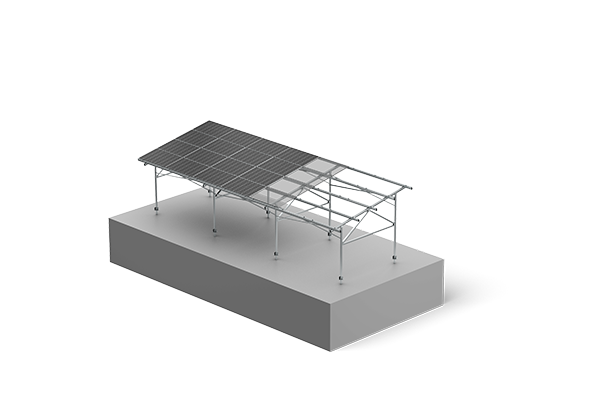Benefits of Agrivoltaics: Sustainable Farming Meets Solar Energy
August 11, 2025
Agrivoltaics, the innovative practice of combining agriculture with solar energy production, is gaining traction as a sustainable solution for modern farming. By utilizing agrivoltaics mount systems, farmers can maximize land use while generating renewable energy. This article discusses the benefits of agrivoltaics, highlighting how it serves as a bridge between sustainable farming and solar energy.

One of the primary advantages of agrivoltaics mount systems is their ability to enhance land efficiency. Traditional farming often competes with solar energy production for available land. However, agrivoltaics allows farmers to use the same parcel of land for both crops and solar panels. This dual use of land not only increases productivity but also helps mitigate the challenge of land scarcity, particularly in regions where arable land is limited.
By incorporating solar panels into agricultural practices, farmers can maintain crop production while simultaneously generating electricity. This synergy can lead to more sustainable farming practices, as it allows for the optimization of resources and reduces the need for additional land conversion.
Another significant benefit of agrivoltaics mount systems is their potential to improve crop resilience. Solar panels provide shade, which can help protect crops from extreme weather conditions, such as intense heat or heavy rainfall. This shading effect can lead to better water retention in the soil and reduce evaporation rates, ultimately benefiting crop health.
Additionally, the presence of solar panels can create a microclimate that fosters more favorable growing conditions. This can be particularly advantageous for farmers dealing with climate variability, as it helps stabilize yields and ensures food security.
Integrating agrivoltaics mount systems into farming operations also creates new revenue opportunities. By generating solar energy, farmers can sell excess electricity back to the grid or utilize it to power their operations. This additional income can help offset rising operational costs and improve the economic viability of farming.
Furthermore, agrivoltaics can attract investment in agricultural technology and renewable energy sectors, promoting innovation and sustainability. As the demand for clean energy grows, farmers who adopt agrivoltaics will be well-positioned to benefit financially from this transition.
In conclusion, agrivoltaics offers numerous benefits, including enhanced land efficiency, improved crop resilience, and additional revenue streams. These advantages make agrivoltaics mount systems a compelling option for farmers looking to integrate sustainable practices into their operations.
At Antaisolar, we provide Agri-PV Solutions with an Individual Array that is highly flexible and adaptable. Our systems are designed to support the unique needs of farmers while promoting renewable energy generation, ensuring a sustainable future for agriculture and energy.

Enhancing Land Efficiency
One of the primary advantages of agrivoltaics mount systems is their ability to enhance land efficiency. Traditional farming often competes with solar energy production for available land. However, agrivoltaics allows farmers to use the same parcel of land for both crops and solar panels. This dual use of land not only increases productivity but also helps mitigate the challenge of land scarcity, particularly in regions where arable land is limited.
By incorporating solar panels into agricultural practices, farmers can maintain crop production while simultaneously generating electricity. This synergy can lead to more sustainable farming practices, as it allows for the optimization of resources and reduces the need for additional land conversion.
Improving Crop Resilience
Another significant benefit of agrivoltaics mount systems is their potential to improve crop resilience. Solar panels provide shade, which can help protect crops from extreme weather conditions, such as intense heat or heavy rainfall. This shading effect can lead to better water retention in the soil and reduce evaporation rates, ultimately benefiting crop health.
Additionally, the presence of solar panels can create a microclimate that fosters more favorable growing conditions. This can be particularly advantageous for farmers dealing with climate variability, as it helps stabilize yields and ensures food security.
Generating Additional Revenue Streams
Integrating agrivoltaics mount systems into farming operations also creates new revenue opportunities. By generating solar energy, farmers can sell excess electricity back to the grid or utilize it to power their operations. This additional income can help offset rising operational costs and improve the economic viability of farming.
Furthermore, agrivoltaics can attract investment in agricultural technology and renewable energy sectors, promoting innovation and sustainability. As the demand for clean energy grows, farmers who adopt agrivoltaics will be well-positioned to benefit financially from this transition.
In conclusion, agrivoltaics offers numerous benefits, including enhanced land efficiency, improved crop resilience, and additional revenue streams. These advantages make agrivoltaics mount systems a compelling option for farmers looking to integrate sustainable practices into their operations.
At Antaisolar, we provide Agri-PV Solutions with an Individual Array that is highly flexible and adaptable. Our systems are designed to support the unique needs of farmers while promoting renewable energy generation, ensuring a sustainable future for agriculture and energy.
end
